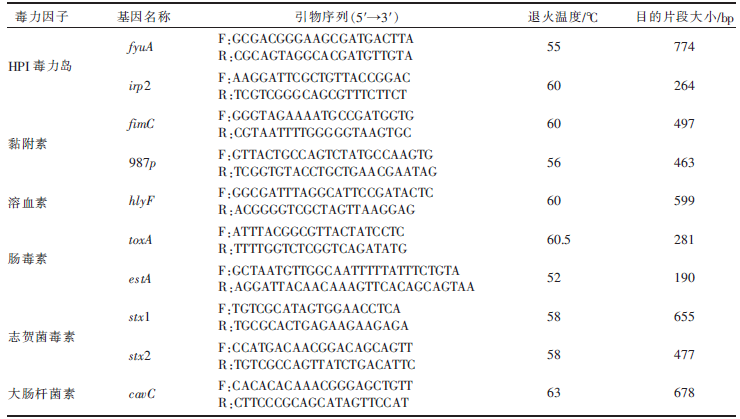畜牧与饲料科学 ›› 2023, Vol. 44 ›› Issue (3): 109-115.doi: 10.12160/j.issn.1672-5190.2023.03.016
广州市某马术俱乐部马源大肠杆菌的分离鉴定、毒力基因检测及耐药性分析
刘鏊1,马丁允1,陀海欣1,李静1,王超男1,孙铭飞2,林栩慧2,齐萌1
- 1.塔里木大学动物科学与技术学院/新疆生产建设兵团塔里木动物疫病诊断与防控工程实验室,新疆 阿拉尔 843300
2.广东省农业科学院动物卫生研究所/广东省畜禽疫病防治研究重点实验室,广东 广州 510640
Isolation,Identification,Virulence Genes Detection and Antimicrobial Resistance Profile of Horse Origin Escherichia coli Isolates from an Equestrian Club in Guangzhou City
LIU Ao1,MA Dingyun1,TUO Haixin1,LI Jing1,WANG Chaonan1,SUN Mingfei2,LIN Xuhui2,QI Meng1
- 1. College of Animal Science and Technology,Tarim University/Engineering Laboratory of Tarim Animal Disease Diagnosis and Control,Xinjiang Production and Construction Corps,Alar 843300,China
2. Institute of Animal Health,Guangdong Academy of Agricultural Sciences/Guangdong Provincial Key Laboratory of Livestock Disease Prevention,Guangzhou 510640,China
摘要:
[目的]分离鉴定广州市某马术俱乐部赛马粪便中的大肠杆菌,检测其毒力基因,并进行耐药性分析。[方法]收集广州市某马术俱乐部20份成年赛马粪便样本,通过细菌培养、革兰染色镜检和细菌16S rDNA序列PCR法分离鉴定大肠杆菌,并对分离菌株进行大肠杆菌系统发育群鉴定;采用PCR法检测10种毒力基因和11种耐药基因,应用K-B纸片法开展药物敏感性试验。[结果]经形态学观察和PCR检测,鉴定出13株大肠杆菌,分离率为65.00%(13/20);系统进化分群分别属于A群(23.07%,3/13)、B1群(61.54%,8/13)和D群(15.38%,2/13);共检出5种毒力基因,分别为fimC(61.54%,8/13)、fyuA(7.69%,1/13)、irp2(7.69%,1/13)、stx1(15.38%,2/13)和stx2(7.69%,1/13);共检出9种耐药基因,分别为parC(100%,13/13)、gyrA(100%,13/13)、gyrB(92.31%,12/13)、sul2(76.92%,10/13)、cmlA(30.77%,4/13)、aadA(23.07%,3/13)、tet(B)(15.38%,2/13)、blaTEM(7.69%,1/13)和blaCTX(7.69%,1/13);13株大肠杆菌分离株对头孢西丁、庆大霉素、环丙沙星敏感,对四环素的耐药率为38.46%,对头孢噻呋、阿米卡星、氨苄西林的耐药率均为30.77%,对氯霉素、甲氧苄啶/磺胺异噁唑和亚胺培南也呈现出不同程度的耐药性。[结论]广州市某马术俱乐部赛马源大肠杆菌种群具有多样性,携带多种毒力基因和耐药基因,呈现多重耐药性,提示临床上应加强马大肠杆菌病的防治。
中图分类号:









